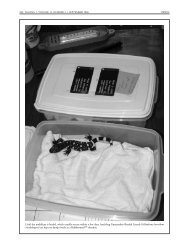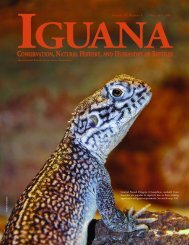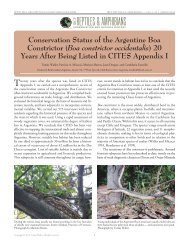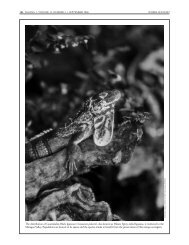Spiny-tailed Iguanas (Ctenosaura similis) in Venezuela
Spiny-tailed Iguanas (Ctenosaura similis) in Venezuela
Spiny-tailed Iguanas (Ctenosaura similis) in Venezuela
You also want an ePaper? Increase the reach of your titles
YUMPU automatically turns print PDFs into web optimized ePapers that Google loves.
ARLINGTON JAMES<br />
ARLINGTON JAMES<br />
AMPHIBIANS AND REPTILES OF DOMINICA<br />
heavy ra<strong>in</strong>s. They feed on a variety of small arthropods, and have<br />
been observed forag<strong>in</strong>g at night for <strong>in</strong>sects attracted to lights.<br />
Predators <strong>in</strong>clude snakes and larger frogs. Fungal <strong>in</strong>fections<br />
(chytridiomycosis) have been documented. This species is<br />
<strong>in</strong>cluded on the IUCN Red List as “near threatened,” due to a<br />
known range of less than 5000 km 2 and potential habitat loss due<br />
to human expansion, volcanism, and hurricanes.<br />
Leptodactylus fallax (Müller 1926). Anura: Leptodactylidae.<br />
Local names: Crapaud, Kwapo, Mounta<strong>in</strong> Chicken. English<br />
common name: Giant Ditch Frog. Native. This species currently<br />
is restricted to Dom<strong>in</strong>ica and Montserrat, although it may once<br />
have occurred on neighbor<strong>in</strong>g islands. These large frogs (maximum<br />
male SVL 159 mm, maximum female SVL 200 mm) are<br />
found <strong>in</strong> association with streams from sea level to elevations of<br />
~400 m. In addition to natural habitats, they can be found <strong>in</strong><br />
deforested areas, gardens, and plantations. Dorsal ground color<br />
is olive-brown, with highly variable pattern elements. They are<br />
sit-and-wait predators, feed<strong>in</strong>g primarily on small arthropods,<br />
but they occasionally take vertebrates such as small rodents, bats,<br />
frogs, lizards, and even snakes (one attempt on a small Boa nebulosa<br />
has been documented). Activity is almost exclusively noc-<br />
Mounta<strong>in</strong> Chickens (Leptodactylus fallax) are large frogs that have been<br />
extensively exploited as a delicacy. Other factors that have contributed<br />
to population decl<strong>in</strong>es are predation by <strong>in</strong>vasive mammals (pigs, cats,<br />
rats, and dogs), habitat loss attributable to human development, volcanism,<br />
hurricanes, and fungal <strong>in</strong>fections.<br />
Dom<strong>in</strong>ican populations of the critically endangered Mounta<strong>in</strong><br />
Chicken (Leptodactylus fallax) have decl<strong>in</strong>ed by 70% s<strong>in</strong>ce 2002 as a<br />
consequence of the chytrid fungus.<br />
IGUANA • VOLUME 15, NUMBER 3 • SEPTEMBER 2008 133<br />
turnal, although some forag<strong>in</strong>g and call<strong>in</strong>g may occur on ra<strong>in</strong>y<br />
days. The species is <strong>in</strong>cluded on the IUCN Red List as “critically<br />
endangered,” largely due to excessive exploitation as a delicacy.<br />
Other factors that have contributed to population decl<strong>in</strong>es are<br />
<strong>in</strong>vasive predators (pigs, cats, rats, and dogs), habitat loss by<br />
human expansion, volcanism, hurricanes, and fungal <strong>in</strong>fections.<br />
Chytridiomycosis was first recognized as a threat <strong>in</strong> December<br />
2002; between 2002 and 2004, the disease is thought to have<br />
reduced populations on Dom<strong>in</strong>ica by 70%.<br />
Lizards (Reptilia: Squamata)<br />
Ameiva fuscata (Garman 1887). Squamata: Teiidae. Local name:<br />
Abòlò. English common name: Dom<strong>in</strong>ican Ground Lizard.<br />
Endemic. These large ground lizards (maximum male SVL 200<br />
mm, maximum female SVL 154 mm) occur <strong>in</strong> lowland habitats<br />
such as coastal scrub, plantations, and open forests, but also<br />
may range to moderate elevations along road edges and <strong>in</strong> artificial<br />
clear<strong>in</strong>gs. Lizards have elongated po<strong>in</strong>ted snouts and long,<br />
stocky tails. Smaller <strong>in</strong>dividuals are a mottled brown with light<br />
blue spots dorsally; large males have a black, slate-gray, to dark<br />
blue ground color with light blue spots. These lizards may run<br />
on their h<strong>in</strong>dlimbs (bipedal) when engaged <strong>in</strong> chases or when<br />
frightened. Ameiva fuscata is a dietary generalist that feeds<br />
opportunistically, usually employ<strong>in</strong>g an active-forag<strong>in</strong>g strategy,<br />
often <strong>in</strong> groups. It typically consumes arthropods, but will eat<br />
fallen fruit and small vertebrates, and is known to prey on<br />
Iguana delicatissima eggs and hatchl<strong>in</strong>gs. Lizards are most active<br />
at high temperatures and under direct sunlight, although they<br />
avoid the extreme mid-day heat. The conservation status of the<br />
species has not been assessed, but it is locally abundant and one<br />
of the most frequently seen lizards on Dom<strong>in</strong>ica.<br />
Male Dom<strong>in</strong>ican Ground Lizards (Ameiva fuscata) often are strik<strong>in</strong>gly<br />
blue (top), whereas females (bottom) reta<strong>in</strong> the juvenile brown color<br />
well beyond maturity.<br />
ROBERT POWELL JOHN S. PARMERLEE, JR.








